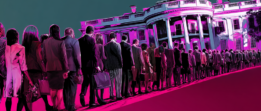As we enter the second year of the COVID pandemic, Purple gathered a group of corporate reputation strategists who have spent the last year helping companies navigate some of the most important and central issues of COVID to identify key challenges that corporate leaders will likely face.
***
Purple is actively partnering with companies and industries to navigate the ever-changing COVID-19 pandemic and prepare for the future that will come after, bringing deep experience helping the world’s best-known companies navigate the world’s toughest challenges. Please reach out to any member of our Purple team to let us know how we can support you.
***
The intersection of the ongoing economic crisis, the continuing pandemic, the social justice movement and increasing inequality are just the short list of what leaders need to acknowledge, manage and help to solve.
Signing well-intentioned letters and making future commitments are sometimes appropriate but will not suffice at this moment. What is needed now are brave and courageous corporate leadership actions that can “bend the K-curve” economic recovery. Creation and adoption of employee policies and culture that accommodate varying degrees of fear, uncertainty, and unique personal circumstances will be essential. Leaders will need to imagine forward rather than look to playbooks of the past.
While companies will continue to deal with the pandemic head-on, we believe they will also increasingly have to navigate COVID in the background through two macro trends: (1) redefining “normal” as we return to normal, and (2) an acceleration of deepening societal divides in need of uniters. As seen through those lenses, here are 10 COVID challenges on the horizon for corporate boards and executive teams.
TREND 1: Return to “Normal”
The very notion of “normal” is now an unknown and shifting target. Corporate leaders must account for a multitude of ofttimes competing expectations from a complex web of stakeholders – employees, customers, communities, government, NGOs, climate activists, social champions – who all see business as critical to shaping a normalcy that works for many. Absent a shared understanding of “normal” or agreed-upon timetable for when that transition should occur, company leaders can expect to both drive and defend their decisions around the parameters of the new normal.
(1) As companies look to “build back better,” the question will be “better” for whom?
“Build back better” represents the Biden team’s economic recovery plan for American workers, pledging to “create millions of good-paying jobs” and to “treat American workers and working families as essential at all times, not just times of crisis.” But the hope for the American economy to be rebuilt in a more equitable way will be met with the reality that the radical changes in how companies worked during the pandemic will continue well past the pandemic’s end.
- Pandemic-necessitated automation is here to stay: The pandemic accelerated an already fast-moving trend away from high-touch jobs toward touchless alternatives – self-checkouts instead of cashiers, chatbots instead of call centers, automated toll tags instead of toll booth attendants, to name just a few. Companies that turned to technology to replace lost productivity during the pandemic are not likely to return to pre-COVID staffing levels, and additional job losses are likely as tech and automation solutions that went into development in the earliest shutdown come online in the days ahead.
- Desire for convenience will prevent return to pre-COVID consumer behaviors: American consumers have also benefited from convenience brought about by necessity – for example, the shift to e-commerce, which the pandemic accelerated by five years according to some estimates. Many consumers who initially adopted new habits during the pandemic to #flattenthecurve will give up their previous behaviors for good. But companies adapting to meet consumers’ shifting expectations and maintain efficiency gains will face reputational risk as a range of stakeholders question decisions that have directly or indirectly resulted in thousands of job losses.
- Transitioning workers will need a new champion: The pandemic has brought about the decline of jobs and industries faster than the impacted workforces can transition, and one of the primary safety nets in previous cycles – public funding of education – is itself a casualty of this pandemic. American businesses have an opportunity to fill this void.
(2) A permanent shift to work-from-home risks setting conditions for decreasing employee loyalty and increasing employee activism.
Many U.S. office workers who found themselves abruptly working from home in the interest of public health have now internalized work location flexibility as an expected benefit in corporate America’s “return to normal.” Companies wishing to retain and attract top talent will have no choice but to codify some level of workplace flexibility, and this shift away from central work locations will have several other potential repercussions.
- Work from home means anyone can work anywhere: Before the shift to remote work, some employees may have chosen to stay with their employer at least in part due to geography. While not the same as having a strong emotional connection to one’s employer, location nonetheless served as a reliable factor in talent retention. Greater work location flexibility will be an enduring effect of the pandemic. Employees will not easily part with what they clearly see as a benefit, and that same flexibility removes the geography-related obstacles to staying with one company.
- Decreasing connection to employers and co-workers: Workplace connections are another factor that fuel company satisfaction and loyalty, and COVID has disrupted the types of personal bonds between co-workers that form through social interactions outside of work. And employees hired during the COVID era have had few if any opportunities to form deep interpersonal relationships and connections with their co-workers at all.
- Company loyalty as a buffer against activism: As workplace personal relationships suffer, so too will company loyalty. Diminishing company loyalty (to the company or its people), in turn, lessens the hesitation some employees might normally feel going public with company issues, or conceals alternative (and more productive) internal avenues employees might have taken in the past to resolve issues and grievances.
(3) The CSR issue landscape will likely narrow but increase in importance in a depression-type era and climate emergency.
In a strong economy, thriving companies can look beyond the basics of their own financial health and security, and individual stakeholders have more leverage to demand companies deliver value beyond the bottom line. But the economic downturn prompted by COVID-19 has pushed many companies into survival mode – focused on business continuity and how to weather a storm of uncertain duration. As the pandemic economy continues, companies will not entirely abandon their CSR efforts, but some initiatives will be temporarily tabled, while others will become increasingly urgent.
- Divide over what to do, when: Partisan differences over which CSR initiatives to pursue and on what timeline won’t just play out in the political arena. They will also shape expectations and pressures on companies from external stakeholders and among their own employees. Conservative-leaning constituencies will push companies to focus on rebuilding the economy while liberal-leaning stakeholders will warn against delaying progress on priorities like social justice and climate change.
- Shared economic realities create attractive common ground: COVID’s economic impact has ignored party lines, making it an issue around which there’s a greater shared reality than many others in this pandemic. Providing economic relief will be a CSR territory on which corporate and political leaders from both sides of the aisle can cooperate.
- Convergence of business and social needs: Rather than forcing the selection of one or the other, companies and policy stakeholders will push for uniting economic and social needs. Action on a priority like infrastructure, for example, will also require making progress on the environment.
(4) The return to work and play will be both quicker and slower than Americans would like. Divergent expectations and lack of societal norms will create significant conflict that businesses will be forced to mediate.
From live events, to happy hours, to handshakes and hugs in social settings, being able to enjoy one another’s company in person again is one of the milestones most coveted by the public. Unfortunately, there will be no magic moment at which that milestone is achieved. Americans will have vastly different perspectives on when specific activities will be safe again, and under what circumstances, and businesses will be among the leading navigators of plotting the course back together.
- Vaccine policies and customer behavior intersect in the real world: Questions and concerns related to the COVID vaccine will move from the realm of public health officials and scientists to the realm of workers on the front line of businesses – the front desk worker in an office, the host or hostess in a restaurant, the greeter in a retail store, and the parking lot attendant at a concert venue, will need to become part of a company’s plans for enforcing the company’s vaccine policy with customers.
- Companies in a difficult position of mediating safety: Once government-directed safety protocols like mask mandates and capacity limitations start to ease, members of the public may still prefer that they continue for comfort and safety reasons. Companies will be in a position to set and enforce their own, custom network of regulations.
- Businesses will have to navigate the space between passionate camps: Compromise and diplomacy are often considered positive approaches to resolving differences, but they will prove to be ineffective in the face of the passions surrounding re-openings. Being in the middle of the “fast” and “slow” is a reputationally violent place to be and will present short- and long-term challenges for companies.
(5) Companies – and managers – will need to face America’s deteriorating mental health as it continues to directly impact the workplace.
News of COVID-19’s monumental impact on mental health is already well-documented. The effects of long-term isolation, reduced access to mental health services, the stress of managing the demands of work and home life, and the economic challenges people have faced, are just a few of many challenges COVID will leave in its wake. The pandemic’s mental health toll will continue having real implications for how businesses operate with employees and other stakeholders.
- Mental health as employer priority: In the near term, employers will be expected to continue investing time and resources into employees’ mental health in the form of mental health care coverage as well as policies like flexible hours, more direct engagement from managers, and health and wellness stipends.
- New spotlight on opioids: Companies already involved in defending against allegations of their role in the opioid crisis will face renewed attention and scrutiny for increases in addiction and dependencies resulting from the COVID era.
- Long-term impact on talent pipeline: While parents and schools are struggling with the learning and achievement gap now, employers will eventually be required to navigate the long-term effects of the “Quarantine Generation” or “Zoomers” – whose experience will have a lasting impact on their values, outlooks, and skillset.
TREND 2: The Acceleration of Deepening Divides, a Coming Reckoning, and the Need for Uniters
Deepening socio-economic divides have been exacerbated by a K-shaped recovery and the emergence of new segments of haves and have nots – who gets COVID, who gets the vaccine, who keeps their jobs. Companies will be forced to examine their own role in creating these divides while people will look to the private sector to bring about a sustained economic and societal recovery.
(6) The collapse of Main Street and small businesses will accelerate corporate reckoning over growing wealth inequality.
While the stock market has rebounded from early pandemic losses and many large corporations have reaped record profits, millions of American workers remain unemployed and more than 100,000 small businesses have permanently shuttered. With their commitment to the well-publicized Business Roundtable pledge serving as backdrop to the pandemic’s uneven devastation, companies will be held to account for their part in building an economy that does not serve all Americans.
- Reckoning and reform mindset: Calls for corporate accountability will grow and become a social and political norm. And with Democrats in full control of the federal government, corporations will see legislation that seeks to dramatically increase broad regulation, corporate accountability, and a rebalance of profits.
- Implications of a K-shaped recovery: As areas of the economy recover at different rates, the K-shaped recovery will have implications for how companies market to a divided customer base of haves and have nots. This will require a carefully calibrated strategy for targeting messaging at those fortunate enough to be on the upside of the K while so many remain in financial hardship.
- The end of “wealth worship” foreshadows broader shift in attitudes: American pop culture’s celebration of extreme wealth has seen a sharp pendulum swing as economic devastation has unequally impacted Americans. Celebrities and influencers who once racked up “likes” for ostentatious displays of wealth are now met with a flood of calls to “read the room.” This cultural shift will be felt across society and business.
(7) Social justice issues will stay front and center. Companies will face pressure to deliver beyond commitments made in 2020.
The disproportionate damage done to Black and Hispanic communities by COVID-19 will continue to surface systemic inequality in our society. In addition to broader social justice issues, three areas will emerge with COVID as the backdrop.
- Vaccine mandates reignite social justice tension and issues: Decades of mistreatment by the healthcare system has led Black Americans to pervasive mistrust of the healthcare industry, resulting in increased COVID vaccine hesitancy and significantly higher resistance to mandatory vaccination. A Purple survey in July 2020 found 51% of Black Americans would rather quit or be fired from their job than be required by their employer to take the vaccine. Vaccination policies for employees and customers may therefore have disproportionate exclusionary impact on people of color.
- Rubber hits the road on “making good”: The backlash over race-based vaccine prioritization plans foreshadows the coming challenges that society, government, and corporations will face as they begin to implement commitments made in the second half of 2020 to address racial equity and social justice.
- Long-term impact on communities: A significantly larger share of Black-owned small businesses have gone out of business, and schools where a majority of students are non-white are less likely to be equipped with the resources and infrastructure to support safe in-person or virtual school. Both of these issues will contribute to short- and long-term equity issues, requiring immediate intervention, and presenting a lane for companies to invest in near-term aid and long-term solutions.
(8) The disappearance of women from the workforce will worsen, undermining diversity, wiping out hard-fought gains in leadership and pay equity, and robbing the future talent pipeline of female leaders.
Forward-looking companies have worked hard to differentiate in the area of gender diversity, investing heavily in attracting, retaining and promoting women; recruiting women to serve on their executive teams and boards; and setting executive KPIs, sustainability goals and public commitments related to advancing women in their workforces. Pandemic burdens being shouldered by women, in particular, are putting all of those gains at risk. Companies will need to enact measures to retain talent and engender loyalty, balancing the sometimes-conflicting needs of parents and non-parents alike, to remain competitive now and protect women leaders for their leadership pipeline.
- Childcare duties continue to derail workdays: As long as schools and daycares remain closed (or inconsistently open), women will continue to take on the overwhelming majority of the resultant child care responsibilities alongside their professional workloads.
- Disappearing jobs are more likely women’s jobs: Women are experiencing a disproportionate number of COVID job losses since they are a large percentage of the workforce in industries hit hardest, such as hospitality, travel, and service.
- COVID economics exacerbate standard gender stumbling blocks: Pre-existing hurdles for women in the workplace, like the gender pay gap and less frequent promotions than male counterparts, mean COVID economic-protection measures like freezes on pay raises and promotions have an outsized impact on women.
- Added insecurity in family finances ripple into broader economy: Fewer female wage earners will translate to less stability in household incomes, and lessened ability for families to make payments on mortgages, credit card debt, student loans, and other needs – not to mention the impact on discretionary consumer spending.
(9) Work from home and work from office will create a two-tiered workforce both within and across companies and industries.
Early on, the pandemic highlighted the split between essential and non-essential workers. Another type of employment divide is about to come into focus as companies navigate their new work normal: the divide between those working from home and not. Some will be able to choose their work location while others will not be given a choice, and employers will have to navigate the different expectations and experiences of both groups.
- Ensuring equitable benefits: Companies will need to develop and apply practices and policies equitably across groups and anticipate and manage the inevitable disparities arising from a two-tiered workforce. For example, companies will need to protect non-working hours for those working from home to ensure they don’t feel like they’re unfairly burdened by blurred work/home lines, or extend comparable flexibility (or something of comparable value) to those working in the office.
- Divides between the can (work from home) and the cannots: Tension will continue to build between employees who want to work from home and aren’t able to and those who can, potentially putting company leaders on the defensive to justify decision-making.
- The in-person/remote team split will solidify: Corporate and team structures will need to shift to effectively accommodate hybrid teams, ensuring productivity across work formats.
(10) The treatment of and reliance on essential workers throughout the pandemic will lead to a re-emergence of labor during the early days of the Biden administration.
Americans have relied on “Essential Workers” throughout the pandemic to provide vital services – including health care, emergency services, food production, and transportation and delivery – that enabled the U.S. economy to keep running. But the treatment of front-line workers has been a particular challenge, as many have worked without basic protections such as PPE, paid sick leave, increases in pay, or job security – and that is on top of many of these jobs being low-wage, to begin with. As the pandemic stretches into a second year and a new administration takes over, better pay and protections for essential workers will be more of a priority than they have been to date.
- Pro-labor federal government: The Biden administration has already signaled that it will be a friendlier environment for labor, including easing restrictions on workers organizing and collective bargaining. With fewer obstacles, a friend in the White House, and majorities in the House and Senate, labor will organize to demand better pay and protections for essential workers in 2021.
- More allies for essential workers: Social justice activists, as well as large swaths of the American public, will support greater protections for the workers who continue to care for America as most of the country remains in quarantine mode for the next several months.
A version of this article first appeared in Fast Company
Purple is actively partnering with companies and industries to navigate the ever-changing COVID-19 pandemic and prepare for the future that will come after, bringing deep experience helping the world’s best-known companies navigate the world’s toughest challenges. This article was developed during a Futurecasting by Purple StrategiesTM workshop by Purple’s Alec Jacobs, Ashley Gibaldi, Bradley Engle, Chris Durlak, Denise Brien, Diana Muggeridge, Erica Goldman, Nate Byer, Nicki Zink, Rebecca Ballard, Robert Fronk, Rory Cooper, and Sarah Simmons. Please reach out to any member of our Purple team to let us know how we can support you.

 What does corporate leadership look like in a divided nation?
What does corporate leadership look like in a divided nation?  Waiting to Engage in D.C. Is the Most Expensive Mistake You’...
Waiting to Engage in D.C. Is the Most Expensive Mistake You’...  The Era of High-Stakes Uncertainty
The Era of High-Stakes Uncertainty  What Forces are Shaping the Future for CMOs?
What Forces are Shaping the Future for CMOs?